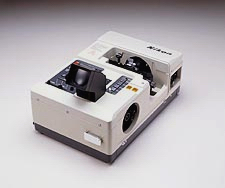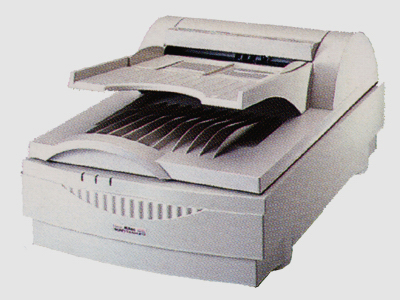Nikon film and flatbed scanners(with assistance of Harry Dekkers)
Coolscan
Introduction In 1984 Nikon introduced, in cooperation with Kyodo News Service, the NT-1000A transmitter system, including a drum scanner with which it was able to scan 35mm. film negatives (max. of 36 frames) and slides. The scans could be controlled on an additional NW-100 monitor and transferred via an telephone line to a receiver somewhere else in the world. Transmission speed was 60, 120 or 240 lines per minute. The scanner had a CCD linear image sensor of 2048 pixels and a 12V halogen lamp. The entire equipment was weighing in at 14 kg. (including an aluminum carrying case), which didn't prevent Nikon to announce that it was possible and allowed to carry the equipment in a plane. It is not known how many sets were produced. In 1988 the NT-2000A transmitter system replaced the 1000A, although the scanner features were almost identical. It was possible to connect a control panel (KY-200/TB-200), including a keyboard and a touch tablet. This new equipment would give problems during checking in at any airport as it was weighing in at 25 kilo plus 6.5 kilo for the keyboard and touch tablet! In 1991 a slimmed down NT-2000 version, sold as NT-3000, was introduced.
Nikon NT-1000A + NW-100
Nikon introduced its first real scanner in late 1987, followed by some so called flatbed scanners and film scanners. A flatbed scanner (Nikon Scantouch flatbed scanners are out of production) is able to scan films as well, but a film scanner is the best tool. For flatbed scanners see below. A film scanner is an instrument to scan a picture, film or slide and to save it digitally. In some cases it is better to touch up a scanned picture on a computer than to touch up a negative film or slide. Nikon makes it very easy to improve bad pictures or pictures that have aged or faded. Its scanners are 'packed' with software, with which one can restore any picture. This software - ROC (restoration of color) - and software to remove dust and dirt - ICE Technology (image correction enhancement) has been developed by Applied Science Fiction (AFS), Atlanta (USA). Nikon is the first producer of photographic equipment using this software. By putting a slide or film in a slot of the scanner the film will be illuminated by LED's (light emitting diodes) and a light sensitive sensor will scan the image. Depending on the scan resolution this may take some time (30 - 120+ seconds). The scan will be digitally saved on the hard disk of a computer in various formats (TIF, JPEG, etc.). Now the image can be retouched with the help of special software. ICE-software is 'looking' (with an additional LED) under a certain angle at a slide or film and removes - digitally - all dust particles that 'rise above' the film emulsion. Nikon has chosen 'Coolscan'- referring to its LED's - as its trade mark for the scanners. Below are the main characteristics of the Nikon scanners. Not all scanners are pictured as the exterior of the scanner bodies of most types are identical. For an overview of older Nikon scanners and compatible software supplied by Nikon see here. Note: When Nikon Scan software 4.0.3 or later is installed you may use Coolscan LS-9000, LS-8000, LS-5000, LS-4000, LS-V and LS-IV under Windows Vista and Windows 7. All other Coolscan and Scantouch devices cannot be used under Windows Vista, Windows 7 and later! Nikon also announced that there will be no updates issued for later operating systems (Microsoft & MacIntosh). A long time scanner software manufacturer has made Silverfast software available for nearly all scanners; see for more info here. Vuescan software, issued by hamrick, is said to work on nearly all scanners, too.
Above images are based on a scan of an AGFA CT-18 color slide photograph - taken back in 1972. On the left a scan - made with a Nikon Coolscan IV - without any improvements and, at the right post-processed with ICE and ROC software. (Original scan 4203 x 2870 pixels; ROC: 6, GEM: 3, ICE: fine and analog gain: neutral).
Coolscan LS-3500 This is the very first Nikon film scanner, introduced in 1988, able to scan 35 mm. films at maximum resolution of 4096 x 6144 pixels. This scanner uses a halogen lamp; most later scanners will make use of LED's. Coolscan LS-10 This scanner - in 2 versions - was introduced in 1992. One version specially destined for computers with a (Microsoft) Digital Operating System (DOS), and one version for computers using MacIntosh - software. Both scanners can be built in a PC (CD-Rom slot) and connected to an internal SCSI-card. Films or slides can be scanned with 2700 dpi. This scanner can be connected to a Nikon NT-2000A image/photo transmitter. Nikon stopped the production of these transmitter since internet does a better job. Coolscan LS-3510 In 1994 this scanner was introduced. It has a lot of improvements: scan resolution is 5000 x 5000 pixels and an auto focus lens. This scanner is compatible to Adobe Photoshop software. Super-Coolscan LS-1000 - LS-100 The first Nikon Super Coolscan. Super is referring to the fast scan time, which has been cut by half. Optical resolution of 2592 x 3888 (= 2700 dpi). Via the SF-100 tray 50 slides in a row can be scanned. Colour depth is 12 bit. Super Coolscan LS-2000 - LS-20 In 1998 this scanner was introduced, able to scan 35 mm. films and slides plus APS-films! Optical resolution equals that of the LS-1000, but this scanner has a 'clean-image'-software, the 'forerunner' of the ICE-software mentioned above. Colour depth is 12 bit. Coolscan LS-4500 This scanner is Nikon's first multi-format scanner. It scans films up to size of 6 x 9 cm. (4 x 5 inch). By using 4 different adapters films can be 'loaded' in a strip or roll and can even be rotated 360 degrees. It is packed with the latest software, a scan-CCD with 5000 pixels and with two separate scan lenses, of which one scans at 1000 dpi and the other at 3000 dpi, enabling to scan a large format film at 5,000 x 18,000 pixels. In this scanner Nikon has put a halogen lamp. Why? Coolscan II LS-20E In 1996 this successor of the LS-1000 is marketed. It has a auto focus lens but a colour depth is 8 bit; maximum resolution is 2700 dpi; scan time just 80 seconds and back to LED's. Coolscan III LS-30E The LS-30, aka Coolscan III, was introduced as the successor of the LS-20 in 1998. It scans 35mm. and APS-films, has an auto focus lens, LED's, image cleaner software (for colour images only), the new Nikon Color Management System and a resolution of 2700 dpi. Coolscan IV LS-40ED Coolscan IV-ED with strip film adapter (right), slide mount adapter & strip film holder (insert) This scanner, introduced in 2001, is the first scanner with USB-connection. It is available for MacIntosh and Microsoft computers, has a scan lens with ED-elements, Silverfast, ICE and ROC (see above) software. As an extra the new GEM-software. GEM (Grain Equalization & Management) eliminates visible grain in film emulsion; much better than FARE-software of 'arch-enemy' Canon or 'Auto Dust' of Minolta. Coolscan LS-4000 ED In 2001 Nikon introduces a Super Coolscan, destined for the professional photographer and desktop publisher (DTP). It has all features of its predecessors, a fast fire-wire connection for DOS- as Mac-computers, many adapters for all kind of films and slides as well as for microscope- and laboratory glass. Resolution is 4000 dpi (what's in a name!). Of course a scan in such a high resolution creates a huge format/file: over 100 Mb. But a fast scan speed and fire-wire connection makes working with this scanner a feast. Coolscan LS-5000 ED A new scanner was introduced in 2003. It has a lot of features as its predecessor, but also a new ED-lens, new CCD-sensor, and a USB 2.0 connection. Interesting is a 16 bit colour depth. Via adapters 50 framed slides or film rolls with a maximum of 40 images can be loaded. A scan in highest resolution takes just 20 seconds. Coolscan LS-8000 ED This scanner, packed with the latest software, was simultaneously introduced with the LS-4000 mentioned before. Its name doesn't refer to 8000 dpi, as its maximum resolution is 4000 dpi. Via adapters it 'eats' all kind of films from 16 mm. movie film via APS, 35 mm. up to 6 x 9 cm. film; and all sizes in between. A full scan in 14 bit of a large film format will give a file format - however - of nearly the maximum capacity of a cd-rom! Coolscan LS-9000 ED This Super Scanner, introduced in 2004, 'swallows' all film-, slide- and lab-glass formats from 16 mm. up to 6 x 9 cm., and scans at 4000 dpi with a colour depth of 16 bit! Novelty here is a relatively large lens (with ED-elements) to cover all large film formats. This scanner is still one of the best scanners in the world. Most scanners above received various prizes and awards. The Coolscan V has got the 2004 TIPA-Award, the Coolscan 4000 the 2002 TIPA-Award and EISA-Award. The Coolscan 8000 the 2002 TIPA-Award etc. etc. Many international photography- and electronics magazines gave most Nikon scanners very positive reviews, too.
As stated in the introduction Nikon also produced flatbed scanners. Due to harsh competition Nikon stopped the production of this type of scanners. 'Let the cobbler stick to his last' probably has been Nikon management's credo. Flatbed scanners are not the best instruments for photographers or all those wishing to scan a film or slide. Nikon produced three flatbed scanners. They were sold in the USA mainly. In Europe they are hard to find. And they were heavily priced, too. An AX-210 was listed at its introduction in 1996 for 1,535.- US Dollars, a transparent lid was listed for some 500 US Dollars extra! A brief review follows.
Scantouch AX-1200 In 1994 Nikon surprises the world with this scanner. It scans A4 documents, prints and film with a resolution of 1200 x 1200 pixels at a colour depth of 10 bit. This scanner has a serial PC-connector. Scantouch AX-110 In 1996 this A4-format flatbed scanner - with an optical resolution of 300 x 600 pixels at 8 bit colour depth - was introduced. Via adapters film and documents can be loaded. Film scans are not great at this resolution. Scantouch AX-210
Nikon´s last A4 flatbed scanner, introduced in 1996, has a maximum optical resolution of 600 x 1200 pixels in 8 bit colour depth. All flatbed scanners mentioned above weren't a world hit. Many competitors, present at the office equipment market for a long time, do have better products. Nikon tried to present some colour printers as well, but failed to get a decent market share. The software of the flatbed scanners is compatible up to Windows 98SE. For later Window-versions adequate software hasn't been made available. For an overview of the compatibility of older software and all Nikon scanners click here.
|

